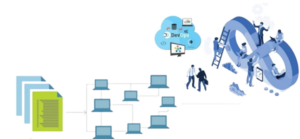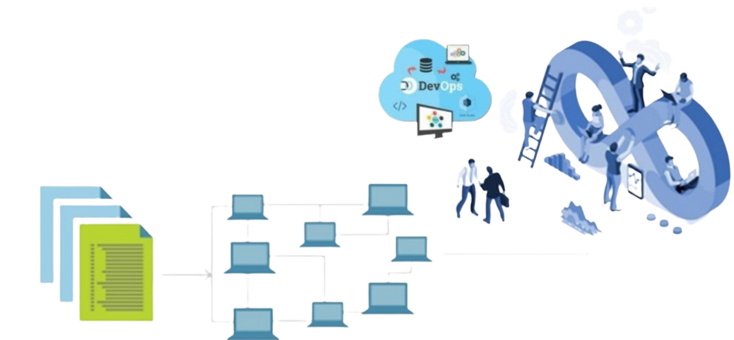Infrastructure as Code (IaC) is a powerful tool for streamlining DevOps processes and making them more efficient and effective. With IaC, DevOps teams can automate the deployment and management of IT infrastructure, including servers, networking, and storage, as well as the deployment of applications and services.
Infrastructure as Code (IaC) is a powerful tool for streamlining DevOps processes and making them more efficient and effective. With IaC, DevOps teams can automate the deployment and management of IT infrastructure, including servers, networking, and storage, as well as the deployment of applications and services. In this blog post, we will explore the benefits of IaC and how it can help organizations to improve their DevOps processes.

Why Adopt Infrastructure as Code?
-
Improved Speed and Efficiency:
One of the biggest benefits of IaC is that it can help DevOps teams significantly speed up the deployment and management of infrastructure. With IaC, teams can define their infrastructure as code, which can then be versioned, tested, and deployed automatically. Reducing the need for manual intervention and speeding up time to market.
-
Infrastructure as Code Improved Consistency and Repeatability:
IaC can also help DevOps teams to improve consistency and repeatability in their infrastructure deployments. With IaC, teams can define their infrastructure in a standardized, repeatable manner, reducing the risk of human error. And ensuring that all deployments are consistent and up to the required standards.
-
Infrastructure as Code Enhanced Collaboration:
IaC can also help DevOps teams to enhance collaboration and increase transparency in their infrastructure deployments. With IaC, teams can share their infrastructure definitions and collaborate more effectively. Reducing the risk of miscommunication and helping to ensure that all team members are on the same page.
-
Better Version Control:
IaC also enables DevOps teams to take advantage of version control and other best practices that are commonly used in software development. With IaC, teams can version their infrastructure definitions, making it easier to track changes. And revert to previous versions if needed.
Benefits of Automating DevOps Processes with IaC
-
Increased Agility:
One of the biggest benefits of automating DevOps processes with IaC is that it can significantly increase agility. By automating routine tasks, DevOps teams can focus on more important, value-adding activities. such as innovation and development, freeing up time and resources to help organizations to be more agile and competitive.
-
Infrastructure as Code Improved Deployment Quality:
Automating DevOps processes with IaC can also help organizations to improve the quality of their deployments. With IaC, teams can ensure that their deployments are consistent and up to the required standards, reducing the risk of human error. And helping to ensure that all deployments are of the highest quality.
-
Infrastructure as Code Enhanced Security:
Automating DevOps processes with IaC can also help organizations to enhance security by reducing the risk of human error. With IaC, teams can ensure that all deployments are secure and up to the required standards, reducing the risk of security breaches and helping to protect the organization’s data and reputation.
-
Better Visibility and Transparency:
Automating DevOps processes with IaC can also help organizations to achieve better visibility and transparency in their infrastructure deployments. With IaC, teams can monitor and track the status of their deployments in real time, making it easier to troubleshoot issues and resolve problems quickly and effectively.
Popular Infrastructure as Code Tools
There are many tools available to help organizations implement Infrastructure as Code (IaC). Some of the most popular IaC tools include:
-
Terraform:
Terraform is a popular open-source tool that allows organizations to automate the deployment and management of their infrastructure. With Terraform, teams can define their infrastructure as code. And use a single configuration file to manage resources across multiple cloud providers.
-
Ansible:
Ansible is an open-source automation tool that helps organizations automate their infrastructure and application deployment. With Ansible, teams can define their infrastructure as code, manage configurations, and automate repetitive tasks.
-
Puppet:
Puppet is a popular open-source tool for managing infrastructure as code. With Puppet, teams can automate the deployment and management of their infrastructure, ensure consistency across environments, and reduce the risk of manual errors.
-
Chef:
Chef is an open-source tool that helps organizations automate their infrastructure and application deployment. With Chef, teams can define their infrastructure as code, manage configurations, and automate repetitive tasks.
-
CloudFormation:
CloudFormation is a service offered by Amazon Web Services (AWS) that helps organizations automate the deployment and management of their infrastructure. With CloudFormation, teams can define their infrastructure as code, manage configurations, and automate the deployment of resources on the AWS platform.
When selecting an IaC tool, it is important to consider the needs and goals of your organization. Factors such as the size of your team, the complexity of your infrastructure, and the cloud providers you use, can all impact your choice of tool. It is also important to consider the level of support and community resources available for each tool, as well as the cost and licensing terms. Ultimately, the goal of IaC is to streamline DevOps processes. And the right tool can help you achieve this by automating the deployment and management of your infrastructure.
Conclusion
Infrastructure as Code (IaC) is an increasingly popular approach for DevOps teams to streamline their processes. And achieve consistency and reliability in their infrastructure. With IaC, organizations can automate the deployment and management of their infrastructure, reduce the risk of manual errors, and improve collaboration among teams. Whether you are just starting your journey with IaC or looking to enhance your existing approach, it is important to understand the best practices, tools, and techniques available to help you succeed. By adopting IaC, organizations can take control of their infrastructure. And create an environment that is scalable, secure, and adaptable to meet the changing demands of the business. With IaC, DevOps teams can focus on delivering high-quality software and services. while relying on automation to manage the underlying infrastructure.
BACK










